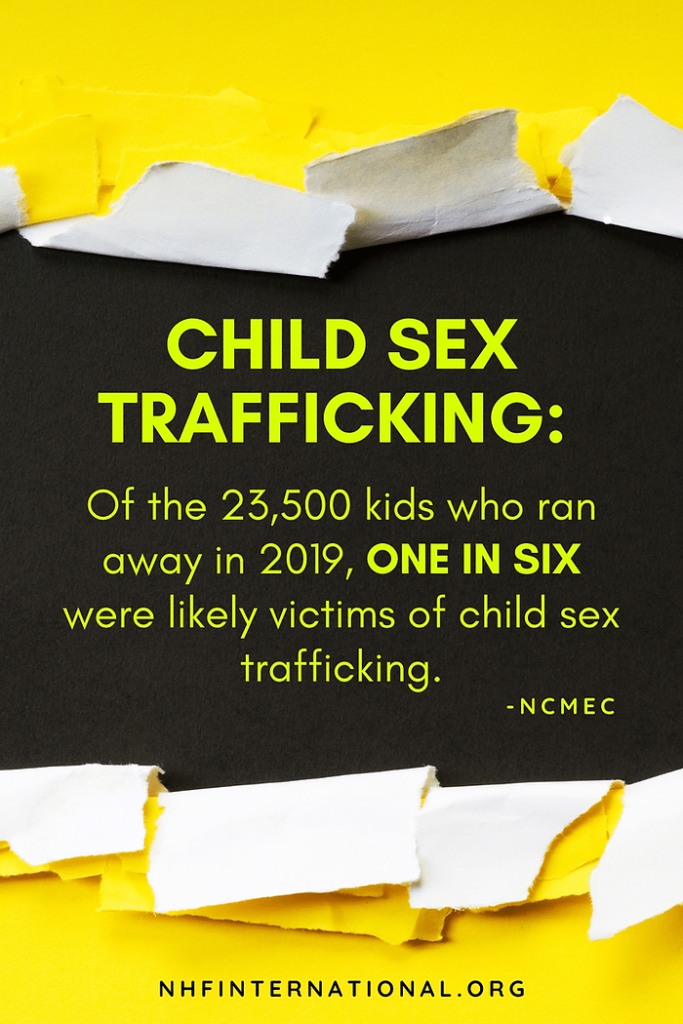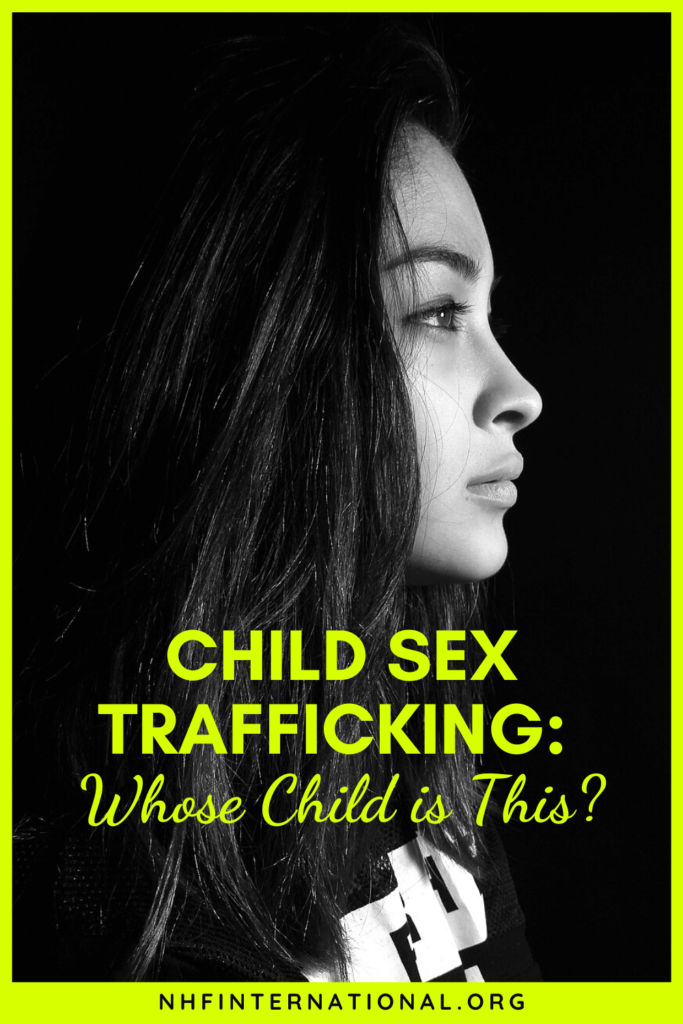Of the 23,500 kids who ran away in 2019, ONE IN SIX were likely victims of child sex trafficking.
(src: https://www.missingkids.org/theissues/trafficking)
Whose child is this?
She is your daughter, sister, niece, granddaughter, friend, neighbor, classmate, student.

How did she get here?
Well, let’s first set the backdrop…
Take for example, a city hub of trafficking – Viva Las Vegas. Without a doubt, Las Vegas is a “sexy” city – with the streets oozing of the infamous motto “Whatever happens in Vegas, stays in Vegas.”
And people take full advantage of that.
Including traffickers, whose sole purpose is to capitalize on the fact that this city stays exactly as it is – an amusement park for adults, where the opportunities to help make a man’s wildest fantasies come true are accessible and endless.
All of which fuels the demand to sell young girls and boys, perking up the ears in the money hungry traffickers’ minds.
So who are these traffickers, you say?
Well, for one, they are masters of manipulation.
They have their PhD in psychological coercion.
Secondly, they wear many disguises.
iEmpathize coined the 5 Ps of disguises that traffickers wear, which are the:
- Pretender – someone pretending to be something or someone they are not
- Provider – someone who will offer to take care of a person’s needs or wants
- Promiser -someone who promises access to great things, like a glamorous lifestyle or a job that’s too-good-to-be true
- Protector – someone who will use physical power or intimidation to protect (but also control) an individual
- Punisher – someone who uses violence and threats to control an individual. When all other disguises have been exhausted, the trafficker will result to violence to maintain control.
Bottom line: there isn’t any one specific profile of a trafficker.
They can be anyone.
They can be male or female. Old or young – like a peer of your child’s. They can be rich or poor. They can be respected members of our community, like coaches, or teachers. They can be family members, friends of the family or strangers. They can be your child’s boyfriend or girlfriend. A gang member, someone posing as a model or talent agent. Even an employer.
A trafficker can be anyone.
A trafficker is someone who seeks to take advantage of vulnerabilities in another individual and exploit them for their own benefit. That is the core of who a trafficker is.
So that’s who they are.
But let’s go deeper.
Let’s get into their mindset…
Here’s a taste at a few quotes from some ex-traffickers:

I looked for girls who were willing to travel and were running away from something or someone.
Any player can tell when a girl has the look of desperation that you know she needs attention or love.
It’s impossible to protect all girls from guys like I was because that’s what we do. We eat, drink and sleep thinking of ways to trick young girls into doing what we want them to do.
src: “From Victims to Victimizers: Interviews with 25 Ex-pimps in Chicago,” Sept 2010.
From this, you can see very clearly what it is traffickers are looking for – who exactly they are targeting.
Traffickers focus on exploiting vulnerable children.
Children who have low self-esteem, lack of confidence, who are unhappy at home, have little or no friends, are chronic runaways.
Any weakness they see, traffickers will turn it into an opportunity to exploit.
How do they do this?
Well, once they’ve targeted a youth, they’ll go in and make their first move.
Which starts with a conversation that appeals to their vulnerability.
Where does this occur?
Everywhere kids are.
Schools, parties, malls, movie theaters, online, bus stops, community centers, airports, etc. Especially online.
Wherever young kids are, you will also find the traffickers.
Watching, scoping, and strategizing.
Once they’ve hooked the child, they will begin the grooming process. This process occurs in order to prepare them for the work they will be forced to endure later on.
Grooming looks like love.
Traffickers buy them gifts, take them out on dates, splurge on them, shower them with love and affection, compliments, and attention. Selling them the dream – the glamorous fantasy.
But what it really is is false love. It’s deceiving.
They lure these young girls into falling in love with them.
Isolating them away from family and friends. Securing their place as the sole provider for everything. Forming this trauma bond.
Then once they have their complete trust, the trafficker turns on the victim and corners her into selling her body.
If we want to have this amazing life together, if you love me you would do this for me…for us…
A convicted pimp was quoted as saying,
You promise a girl heaven and they’ll follow you to hell.
Which pretty much sums up their whole strategy.
Bottom line is that trafficking is a business, where the traffickers profit off of exploiting young girls’ (and boys’) bodies.

What does this look like to you when this grooming process is happening?
It looks like a rebellious child.
But there are some important red flags to take note of:
- new designer items
- older boyfriend & obsessed with the new bf
- new tattoo (form of branding)
- physical injuries
- different set of friends
- more secretive and defiant
- gone for long periods of time
When your child is fully emerged in the life, it’s challenging to get them out of it.
Why? Because (1) it’s dangerous – she’s his source of money; (2) she doesn’t realize that she’s being victimized; (3) she can’t get out of it – unless she’s arrested, she’s escaped, etc.
What you can do when you suspect your child is being victimized
- Call law enforcement. Call the non-emergency line (unless your child is in immediate danger that you know of). Tell them that you’d like to speak to someone who investigates human trafficking crimes because you suspect your child is a victim of one. Let them know your child’s situation. Gather as much intel (texts, emails, phone calls via phone bill, etc.) that you can to help the case.
- Be there for your child. Let them know that you are there for them anytime they need to talk about anything. Show them how much you love them. Pray for them.
- But the best thing you can do, is PREVENT them from falling prey in the first place. As I’ve laid out to you, traffickers are looking for broken people. And some of the most broken people are the ones who suffered the most from their primary relationships – their parents.
So it starts in the family.
Don’t worry! I’m not going to leave you hanging my friend!
I’ve got a FREE 2-page guide for you to get started!
Inside the guide, you’ll get:
- 3 things you can do with your children to improve your relationship, including a fail-proof communication strategy for when they’re in an uncomfortable situation
- how to create a safety plan for your child
- some of my favorite prevention tools & resources

